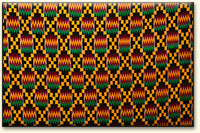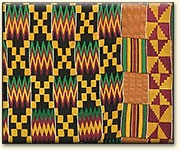Kente Cloth
One of the most sumptuously colored textiles used for clothing is Ghanaian kente cloth, made by Asante and Ewe weavers using specially designed looms. Kente was probably introduced from the western Sudan during the 16th century, when heavy, elaborate, labor-intensive versions of this fabric were designed for wealthy tribal chiefs and simpler designs became available for the general citizenry. Kente is woven in four-inch (9.5 cm) narrow strips that are sewn together. A characteristic Asante kente has geometric shapes woven in bright colors along the entire length of the strip, while Ewe kente often displays a tweed effect by plying together different colored threads in many of the warps. Ewe kente may also incorporate pictorial symbols.
The visual effects of kente cloth are analogous to Western painting’s sharp division between flat shapes of pure colors (simultaneous contrast) found in works by Piet Mondrian, Bridget Riley, or Jim Lambie compared with the interaction of small areas of colors in details paintings by Monet or in Seurat’s La Grande Jatte.

Detail of hand-woven Asante (Ashante) ceremonial cloth featuring red and yellow (primary colors), green (secondary color, complementary to red), and black (neutral color and the darkest tone available).
Originally, kente cloth was black and white, but dyes were developed from different plants and a range of colors evolved. Blue was obtained from the indigo plant, red from dried cam wood, brown from Indian tamarind, and green from boiled spinach leaves. With increased trade, imported silks and cottons were unraveled to extend the color range. Colors convey mood, dark shades being associated with grief and used for mourning ceremonies, while lighter shades are associated with happiness. The symbolic significance of kente is located in the motifs (the elephant signifies kingship, the scorpion bitterness). The colors of the Ghanaian national flag – red, yellow, green and black – are popular in modern cloths.
Kente cloth is characterized by sharply defined shapes created by the technique of loom weaving. It is easier to weave geometric than organic shapes, so rectangles, diamonds, zigzags, and squares are predominant. Colors and tones interact along their straight edges, creating optical vibrations as the eye attempts to accommodate constantly changing visual stimuli. Although weavers do not consciously apply the scientific color theory established by the color wheel, they tend to work with abrupt contrasts of tone and hue.
In the hand-woven Asante (Ashante) ceremonial cloth (left), the colors remind Ghanaians of their national identity, but within the cloth they create a dynamic sense of spatial movement. The orange-yellow squares advance and - as the lightest tone - the yellow shimmers against the dark blacks, while red and green zigzag shapes compete with one another. The predominance of angled shapes creates staccato rhythms, making the cloth suitable for use in ceremonies distinguished by repetitive drumbeats and vigorous dancing. A restful pattern would be completely misplaced in performances that build to dramatic crescendos. When worn by rulers, the brilliant cloths attract visual attention, sustaining the concept of authority. The yellow-gold within the cloth is invariably repeated in the gold regalia carried by the ruler.
